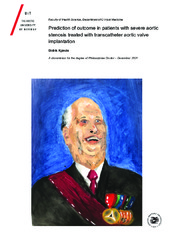| dc.description.abstract | Surgical aortic valve replacement (SAVR) has until the last decade been the standard treatment for patients with aortic stenosis (AS). However, many patients were not offered surgical treatment due to high age or unacceptable surgical risk estimated by surgical risk scores.
Transcatheter aortic valve implantation (TAVI) is a less invasive treatment modality where the valve is implanted using a catheter. Initially reserved for patients not eligible for open surgery, TAVI is now performed in patients with intermediate and even low risk for open surgery.
Despite expanding indications to include lower risk patients, one of the main challenges in clinical practice is evaluating patients not candidates for SAVR where the question arises whether or not they will tolerate and/or benefit from interventional treatment. Surgical risk scores have shown rather low accuracy predicting unfavourable outcome in patients treated with TAVI. Several TAVI specific risk scores have been developed, albeit none has been incorporated into routine clinical practice.
We investigated if preoperative echocardiographic measures, including speckle-tracking analysis, in addition to clinical parameters could aid in the prediction of unfavourable early and mid-term outcome after TAVI in high-risk elderly patients with AS. Furthermore, it aims to evaluate how novel TAVI risk scores perform compared to established surgical risk scores in this population.
We found both clinical and echocardiographic parameters to be predictive of short and mid-term mortality after TAVI. However, speckle-tracking analysis for left-and right ventricular functional assessment did not yield additional predictive value. Risk scores specific for TAVI showed a trend toward better predictive accuracy compared to surgical risk scores.
A multimodal and multidisciplinary approach is needed when evaluating elderly high-risk patients for TAVI with no single clinical or echocardiographic parameter being the decisive factor. Risk scores are best used as a foundation for informed consent rather than exclusion from interventional treatment. | en_US |
| dc.relation.haspart | <p>Paper I: Kjønås, D., Dahle, G., Schirmer, H., Malm, S., Eidet, J., Aaberge, L., … Rösner, A. (2019). Predictors of early mortality after transcatheter aortic valve implantation. <i>Open Heart, 6</i>(1), e000936. Also available in Munin at <a href=https://hdl.handle.net/10037/16335>https://hdl.handle.net/10037/16335</a>.
<p>Paper II: Kjønås, D., Dahle, G., Schirmer, H., Malm, S., Eidet, J., Aaberge, L., … Rösner, A. (2021). Risk scores for prediction of 30-day mortality after transcatheter aortic valve implantation: Results from a two-center study in Norway. <i>Health Science Reports, 4</i>(2), e283. Also available in Munin at <a href=https://hdl.handle.net/10037/23850>https://hdl.handle.net/10037/23850</a>.
<p>Paper III: Kjønås D, Schirmer H, Aakhus S, Eidet J, Malm S, Aaberge L, Busund R, Rösner A: Clinical and echocardiographic parameters predicting 1-and-2-year mortality after transcatheter aortic valve implantation. <i>Frontiers in Cardiovascular Medicine - Heart Valve Disease, 8</i>, 739710. Also available in Munin at <a href=https://hdl.handle.net/10037/23971>https://hdl.handle.net/10037/23971</a>. | en_US |


 English
English norsk
norsk
